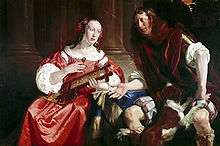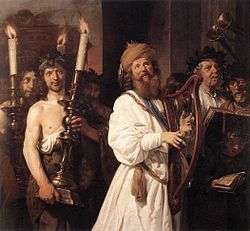Jan de Bray

Jan de Bray (ca.1627 – April 4, 1697), was a Dutch Golden Age painter.
Biography


Jan de Bray was born in Haarlem. According to Houbraken he was the most famous pupil of his father, the architect and poet Salomon de Bray.[1] Houbraken called Jan the "pearl in Haarlem's crown".[1] Houbraken saw a painting by de Bray of David and the Return of the Ark of the Covenant in the collection of Arnoud van Halen in Amsterdam, dated 1697, that he admired for its realistic flesh tones in the forms of David playing the harp and the Levites behind him. Houbraken also mentioned some black and red chalk drawings by him that he saw at the Amsterdam home of Isaak del Court.[1]
He spent most of his career working in Haarlem, where he was for many years dean of the Haarlem Guild of St. Luke.[2] His brother Dirck de Bray was a flower painter who later became a monk in the monastery at Gaesdonck near Goch.[1] His brother Joseph was also a painter.[2] His mother was Anna Westerbaen, the sister of the painter Jan Westerbaen[2] and the poet Jacob Westerbaen.
De Bray survived most of his family during an outbreak of the plague in Haarlem in 1664. He lost his father and two siblings within a month of each other. His wives - Maria van Hees whom he married 21 October 1688,[3] Margaretha de Meyer whom he married in 1672,[4] and Victoria Stalpert van der Wielen whom he married 30 January 1678,[3] each died before him; Victoria shortly after giving birth to their son, Johan Lucas. In 1689 he was declared bankrupt as a Haarlem citizen and moved to Amsterdam, where he died, though he was buried in Haarlem.[2]
Works
_-_WGA03122.jpg)
Jan de Bray was influenced by his father, Bartholomeus van der Helst, and Frans Hals. De Bray's works are mainly portraits, often of groups. He specialised in historical allegories. Among his finest works are two versions of the Banquet of Cleopatra, using his own family, including himself, as models (Royal Collection, 1652, and Currier Museum of Art, New Hampshire, 1669). The second version has great pathos, as most of those depicted had died in the plague of 1663-4.[5]
 Bacchus, showing loose brush strokes
Bacchus, showing loose brush strokes The Adoration of the Magi, a typical altarpiece for a schuilkerk
The Adoration of the Magi, a typical altarpiece for a schuilkerk Head of a Boy. The Walters Art Museum.
Head of a Boy. The Walters Art Museum.
| Wikimedia Commons has media related to Jan de Bray. |
References
- 1 2 3 4 (Dutch) Salomon de Bray Biography in De groote schouburgh der Nederlantsche konstschilders en schilderessen (1718) by Arnold Houbraken, courtesy of the Digital library for Dutch literature
- 1 2 3 4 Jan de Bray in the RKD
- 1 2 "Geschiedkundige aanteekeningen over Haarlemsche Schilders en Andere Beoefenaren van de Beeldende Kunsten" p. 247 books.google.com 23 September 2011
- ↑ "Jan de Bray" russianpaintings.net 23 September 2011
- ↑ Christopher Lloyd, Enchanting the Eye, Dutch Paintings of the Golden Age, pp. 49-52, Royal Collection Publications, 2004, ISBN 1-902163-90-7.
External links
- Jan de Bray on Artnet
- Works and literature on PubHist
- Murray, P. & L. (1996). Dictionary of art and artists (p. 65). London: Penguin Books. ISBN 0-14-051300-0. (For details see: Sources)
- Jan De Bray and the Classical Tradition at the National Gallery of Art, Washington - 16pp pdf exhibition brochure
- Entry for Jan de Bray in the RKD, the Netherlands Institute for Art History